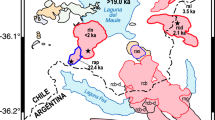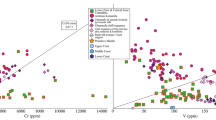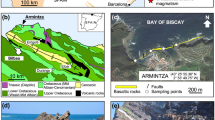Abstract
The physico-chemical parameters of crystallization of the Early Cretaceous Velitkenay granite–migmatite pluton (Arctic coast of Chukotka, near Cape Billings) are reconstructed using mineral thermobarometry and oxybarometry. The magmatic rocks are dominated by monzonitic rocks (quartz monzodiorites and monzodiorites), with less common granodiorites and leucogranites. The limitations on and critical parameters of the amphibole composition are considered for correct application of thermobarometry. The most reliable pressure estimations for the early-phase monzonitic rocks are calculated using an amphibole geobarometer range from 2.2 to 4.2 kbar. The calculated crystallization temperature varies from 684 to 823°C (plagioclase–amphibole geothermometer) at oxygen fugacity from +0.2 to +0.7 relative to NNO buffer. The obtained P–T data on the Velitkenay monzonitic rocks are consistent with the conditions of amphibolite facies metamorphism typical of the Chukotka granite–metamorphic domes, the formation of which is related to post-collisional extension.








Similar content being viewed by others
REFERENCES
Yu. M. Bychkov, Structural-Facies Zoning and Biostratigraphy of Triassic, Chukotka (SVNTs DVO RAN, Magadan, 1994) [in Russian].
A. V. Volkov and I. A. Voronin, “Gold–quartz mineralization of the Kuul anticlinal zone, Northern Chukotka,” Kolyma, No. 1, 41–58 (1993).
M. L. Gel’man, “Phanerozoic granite-metamorphic domes on Northeast Siberia. Paper 1. geological history of the Paleozoic and Mesozoic domes,” Tikhookean. Geol. 14 (4), 102–115 (1995).
M. L. Gel’man, “Phanerozoic granite-metamorphic domes on Northeast Siberia. Paper 2. Magmatism, metamorphism, and migmatization in the Late Mesozoic domes,” Tikhookean. Geol. 15 (1), 84–93 (1996).
Geodynamics, Magmatism, and Metallogeny of East Russia, Ed. by A. I. Khanchuk (Dal’nauka, Vladivostok, 2006) [in Russian].
D. V. Dudkinskii, S. V. Efremov, and V. D. Kozlov, “Geochemical features of Mesozoic granitoids of the elevated basicity of the eastern coast of the Chaun Gulf (Chukotka),” Tikhookean. Geol., No. 6, 74–84 (1993).
S. V. Efremov, Extended Abstract of Doctoral Dissertation in Geology and Mineralogy (SO RAN, Irkutsk, 2012) [in Russian].
V. G. Zheltovskii, State Geological Map of the USSR. 1 : 200 000. 1st Edition. Ser. Anyui–Chaun. Sheet R-60-XXVII, XXVIII: Explanatory Notes (TsKTE SVTGU, Magadan, 1980) [in Russian].
M. V. Luchitskaya, S. D. Sokolov, and G. E. Bondarenko, S. M. Katkov, “Composition and geodynamic setting of granitoid magmatism in the Alyarmaut Uplift, western Chukchi Peninsula,” Geochem. Int. 48 (9), 891–916 (2010).
A. P. Milov and B. C. Ivanov, “Late Mesozoic granitoids of Central Chukotka,” in Late Mesozoic Granitoids of Chukotka (Magadan, 1965), pp. 141–187 [in Russian].
A. P. Milov, Late Mesozoic Granitoid Formations of Central Chukotka (Nauka, Novosibirsk, 1975) [in Russian].
L. L. Perchuk, Thermodynamic Regime of Deep Petrogenesis (Nauka, Moscow, 1973) [in Russian].
G. O. Polzunenkov, V. V. Akinin, and I. Yu. Cherepanova, New Data on the Age and Composition of the Velitkenai and Kuekvun Granite–Gneiss Massifs (Arctic Chukotka): Application to the Development of the Models of Granite Formation, (SVKNII DVO RAN, Magadan, 2011) [in Russian].
O. M. Rosen and B. C. Fedorovskii, Collisional Granitoids and Delamination of the Earth’s Crust (Nauch. Mir, Moscow, 2001) [in Russian].
P. L. Tikhomirov, Extended Abstract of Candidate’s Dissertation in Geology and Mineralogy (St. Petersburg, 1998).
P. L. Tikhomirov and M. V. Luchitskaya, “Cretaceous granites of Northeast Asia. Part 2. mineral composition and crystallization conditions,” Vestn. Mosk. Gos. Univ., Ser. 4: Geol, No. 6, 9–15 (2006).
P. L. Tikhomirov, M. V. Luchitskaya, and A. Shats, “Age of granitoid plutons, North Chukotka: problem formulation and new SHRIMP U–Pb zircon datings,” Dokl. Earth Sci. 440 (4), 1363–1366 (2011).
V. V. Akinin, M. L. Gelman, B. M. Sedov, J. M. Amato, M. L. Elizabeth, J. Toro, A. T. Calvert, R. M. Fantini, J. E. Wright, and B. A. Natal’in, “Koolen metamorphic complex, NE Russia: implications for the tectonic evolution of the Bering Strait region,” Tectonics 6, 713–729 (1997).
V. V. Akinin and A. T. Calvert, “Cretaceous mid-crustal metamorphism and exhumation of the Koolen Gneiss Dome, Chukotka Peninsula, northeastern Russia,” Tectonic Evolution of the Bering Shelf–Chikchi Sea–Arctic Margin and Adjacent Territories, Ed. by E.L. Miller, A. Grantz, and S. Klemperer (Eds.), Geol. Soc. Am. 360, 147–165 (2002).
V. V. Akinin, E. L. Miller, E. S. Gottlieb, and G. O. Polzunenkov, “Cretaceous magmatism in the Russian sector of the Arctic Alaska–Chukotka microplate (AACHM),” AGU Fall Meeting (2011).
J. L. Anderson and D. R. Smith, “The effects of temperature and fO2 on the Al-In-Hornblende Barometer,” Am. Mineral. 80 (5), 549–559 (1995).
J. L. Anderson, “Status of thermobarometry in granitic batholiths,” Trans. R. Soc. Edinburgh Earth Sci. 87, 125–138 (1997).
J. D. Blundy and T. J. Holland, “Calcic amphibole equilibria and a new amphibole-plagioclase geothermometer,” Contrib. Mineral. Petrol. 104 (2), 208–224 (1990).
S. C. Challener and A. F. Glazner, “Igneous or metamorphic? Hornblende phenocrysts as greenschist facies reaction cells in the half dome granodiorite, California,” Am. Mineral. 102, 436–144 (2017).
S. Erdmann, C. Mattel, M. Pichavant, and A. Kushnir, “Amphibole as an archivist of magmatic crystallization conditions: problems, potential, and implications for inferring magma storage prior to the paroxysmal 2010 eruption of Mount Merapi, Indonesia,” Contrib. Mineral. & Petrol 167, 1016–1038 (2014).
J. Fabries, F. Conquere, and G. Arnaud, “The mafic silicates in the Saint Quay-Portrieux gabbro–diorite intrusion: crystallization conditions of a calc-alkaline pluton,” Bull. Mineral. 107, 715–736 (1984).
M. C. Gilbert, R. T. Helz, R. K. Popp, et al., “Experimental studies of amphibole stability,” Amphiboles: Petrology and Experimental Phase Relations, Ed. by D. R. Veblen and P. H. Ribbe, Mineral. Soc. Amer., Rev. Mineral. 9B, 229–353 (1982).
A. Giret and J. M. Leger, “Amphibole compositional trends in oversaturated alkaline plutonic ring-complexes,” Can. Mineral. 18, 481–495 (1980).
J. Blundy, “Non-ideal interactions in calcic amphiboles and their bearing on amphibole-plagioclase thermometry,” Contrib. Mineral. Petrol 116, 433–447 (1994).
L. S. Hollister, G. C. Grissom, E. K. Peters, et al., “Confirmation of the empirical correlation of Al in hornblende with pressure of solidification of calc-alkaline plutons,” Am. Mineral. 72 ((3-4)), 231–239 (1987).
F. Holtz, W. Johannes, N. Tamic, et al., “Maximum and minimum water contents of granitic melts generated in the crust: a reevaluation and implications,” Lithos 56, 1–14 (2001).
S. Ishihara, “The magnetite-series and ilmenite-series granitic rocks,” Mining Geol. 27, 293–305 (1977).
E. Jarosewich, J. A. Nelson, and J. A. Norbers, “Reference samples for electron microprobe analysis,” Geostand. Newslett. 4, 43–47 (1980).
M. C. Johnson and M. J. Rutherford, “Experimental calibration of the aluminum-in-hornblende geobarometer with application to Long Valley Caldera (California) volcanic rocks,” Geology 17 ((9)), 837–841 (1989).
B. E. Leake, A. R. Woolley, C. E. Arps, W. D. Birch, M. C. Gilbert, J. D. Grice, F. C. Hawthorne, A. Kato, H. J. Kisch, and V. G. Krivovichev, “Nomenclature of amphiboles: report of the Subcommittee on Amphiboles of the International Mineralogical Association Commission on New Minerals and Mineral Names,” Mineral. Mag. 61 (2), 295–321 (1997).
B. E. Leake and A. R. Woolley, W. D. Birch, et al., “Nomenclature of amphiboles: additions and revisions to the International Mineralogical Association’s amphibole nomenclature,” Am. Mineral. 89, 883–887 (2004).
E. L. Miller, S. M. Katkov, V. V. Akinin, and T. A. Dumitru, “Geochronology and thermochronology of Cretaceous plutons and metamorphic country rocks, Anyui—Chukotka fold belt, North East Arctic Russia,” Origin of Northeastern Russia: Paleomagnetism, Geology and Tectonics, Eds. by D.B. Stone et al., (Stephan Mueller Publ. Ser., 2009), pp. 157–175.
E. Mutch, J. Blundy, B. Tattitch, et al., “An experimental study of amphibole stability in low-pressure granitic magmas and a revised Al-in-hornblende geobarometer,” Contrib. Mineral. Petrol. 85, 27 (2016).
R. Powell and T. J. B. Holland, “On thermobarometry,” J. Metamorph. Geol 26, 155–179 (2008).
F. Ridolfi, A. Renzulli, and M. Puerini, “Stability and chemical equilibrium of amphibole in calc-alkaline magmas: an overview, new thermobarometric formulations and application to subduction-related volcanoes,” Contrib. Mineral. Petrol. 160, 45–66 (2009).
F. Ridolfi and A. Renzulli, “Calcic amphiboles in calc-alkaline and alkaline magmas: thermobarometric and chemometric empirical equations valid up to 1130°C and 2.2 GPa,” Contrib. Mineral. Petrol. 163, 877–895 (2012).
M. W. Schmidt, “Amphibole composition in tonalite as a function of pressure: an experimental calibration of the Al-in-hornblende barometer,” Contrib. Mineral. Petrol. 110 (2–3), 304–310 (1992).
F. S. Spear, “Amphibole–plagioclase equilibria: an empirical model for the reaction albite. Tremolite edenite. 4 Quartz,” Contrib. Mineral. Petrol. 77, 355–364 (1981).
E. Stein and C. Dietl, “Hornblende thermobarometry of granitoids from the Central Odenwald (Germany) and their implications for the geotectonic development of the Odenwald,” Mineral. Petrol. 72, 185–207 (2001).
A. L. Streckeisen, “To each plutonic rock its proper name,” Earth Sci. Rev. 12, 1–33 (1976).
W. Thomas and W. G. Ernst, “The aluminum content of hornblende in calcalkaline granitic rocks; a mineralogic barometer calibrated experimentally to 12 kbars,” Fluid–Mineral Interactions: a Tribute to H. P. Eugster," Ed. by R. J. Spencer and I.-M. Chou, Geochem. Soc. Spec. Publ. 2, 59–63 (1990).
P. Tikhomirov, M. R. Luchitskaya, and I. Kravchenko-Berezhnoy, “Comparison of Cretaceous granitoids of the Chaun tectonic zone to those of the Taigonos Peninsula, NE Asia: rock chemistry, composition of rock forming minerals, and conditions of formation,” Stephan Mueller Spec. Publ. Ser. 4, 289–311 (2009).
R. Turnbull, C. J. Deering, A. D. Tulloch, and S. Weaver, “Second boiling effects on the Al-content of hornblende rims from an exhumed Cretaceous Arc Pluton, Stewart Island, New Zealand,” Am. Mineral. 97, 1129–1144 (2012).
C. R. Vyhnal, H. Y. McSween, and J. A. Speer, “Hornblende chemistry in southern Appalachian granitoids: implications for aluminum hornblende thermobarometry and magmatic epidote stability,” Am. Mineral. 76, 176–188 (1991).
A. R. White and B. W. Chappell, “Granitoids types and their distribution in the Lachlan Fold Belt, southeastern Australia,” Mem. Geol. Soc. Am. 159, 21–34 (1983).
ACKNOWLEDGMENTS
The studies were partially supported by the Russian Foundation for Basic Research (project no. 16-05-00949).
We are grateful to V.V. Akinin and M.L. Gelman for consultation and help in manuscript preparation. We are also grateful to an anonymous reviewer, whose comments significantly improved the manuscript.
Author information
Authors and Affiliations
Corresponding author
Additional information
Recommended for publishing by V.V. Akinin
Translated by M. Bogina
Rights and permissions
About this article
Cite this article
Polzunenkov, G.O. Evaluation of P–T and fO2 Conditions of Crystallization of Monzonitic Rocks of the Velitkenay Granite–Migmatite Massif (Arctic Chukotka) Based on Mineral Thermobaro- and Oxybarometry. Russ. J. of Pac. Geol. 12, 429–442 (2018). https://doi.org/10.1134/S1819714018050081
Received:
Published:
Issue Date:
DOI: https://doi.org/10.1134/S1819714018050081




